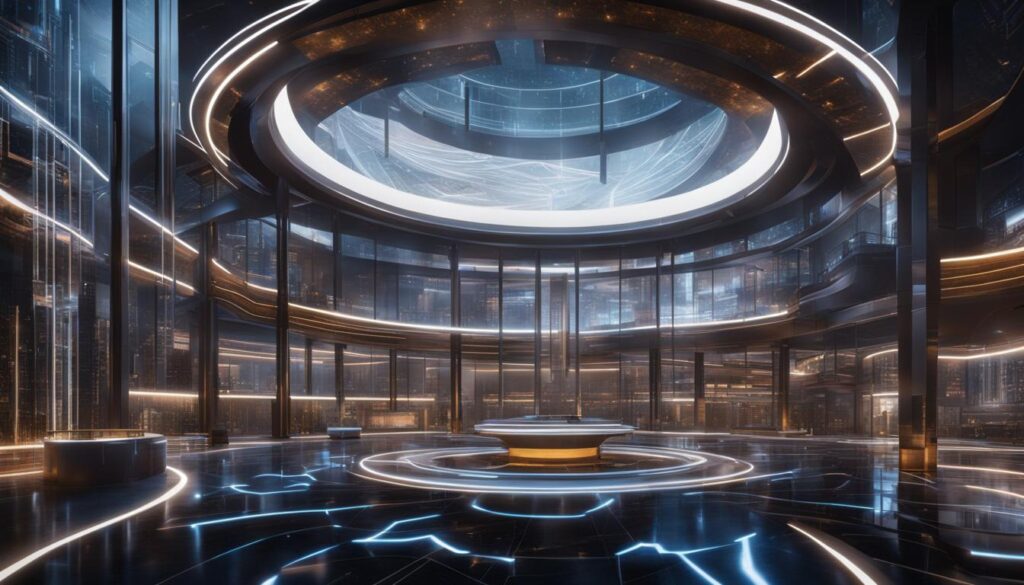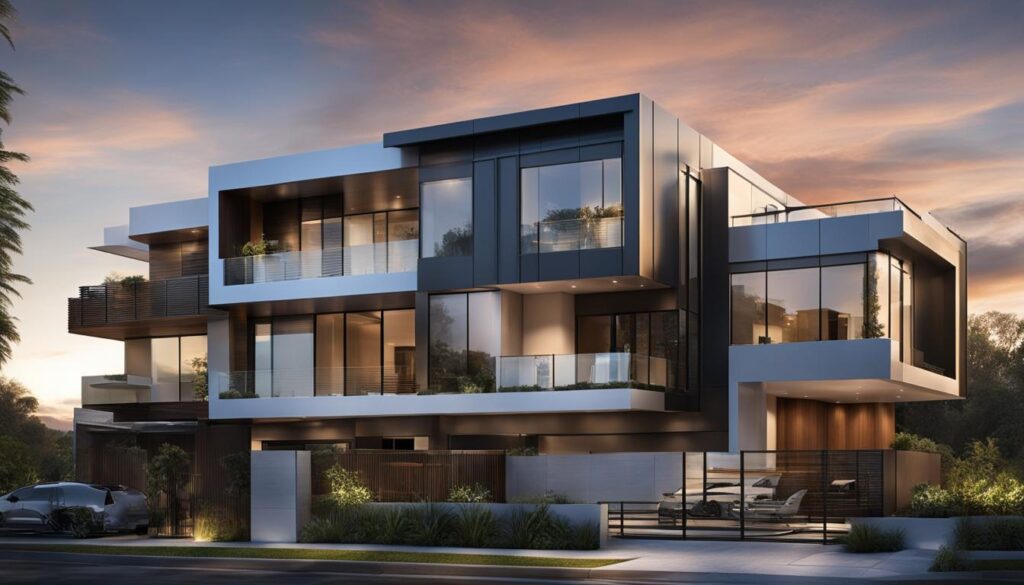We may earn money or products from the companies mentioned in this post.
Augmented reality has become an increasingly popular technology in the field of architectural marketing. It allows architects to provide clients with immersive experiences that help them visualize projects before they are built. Immersive technology in architecture, such as augmented reality, can enhance the design process and improve client experiences. Moreover, AR marketing strategies can efficiently promote and sell architectural projects by providing an interactive and engaging experience for potential clients.
As we delve deeper into the potential of augmented reality in architectural marketing, we discover the transformative impact it can have on the industry. In the following sections, we will explore how augmented reality is revolutionizing architectural visualization, enhancing property marketing, and how it is utilized to effectively promote and sell architectural projects through various AR marketing strategies.
Key Takeaways
- Augmented reality is an innovative technology in architectural marketing that enhances the design process and improves client experiences.
- Immersive technology in architecture is being used to create interactive and engaging AR experiences that promote and sell architectural projects more efficiently.
- AR marketing strategies can help architects showcase their work to potential clients in a more engaging and interactive way.
- Augmented reality technology is revolutionizing architectural visualization and enhancing the way property is marketed to buyers.
- Leveraging 3D modeling and creating immersive AR experiences are vital to providing accurate and detailed architectural visualization.
Revolutionizing Architectural Visualization with Augmented Reality
Architectural visualization has come a long way since the days of hand-drawn sketches and physical models. With the advent of computer-aided design (CAD) and 3D modeling software, architects can create highly detailed and accurate visual representations of their designs.
However, even the most sophisticated 3D models can only provide a limited view of a building’s design, leaving clients with a partial understanding of the finished product. This is where augmented reality (AR) comes in.
“Augmented reality is the integration of digital information with the user’s environment in real-time. It provides a new way to visualize and experience architectural design.”
By overlaying digital information onto a real-world view, AR allows clients to interact with a virtual model of a building in real-time. This level of interactivity provides a more immersive experience than traditional 3D models, allowing clients to explore design features and make informed decisions about the building’s final appearance.
Virtual reality (VR) is another immersive technology used in architecture, but AR has the advantage of enhancing the design process rather than replacing it. While VR requires users to wear a headset and enter a completely virtual environment, AR allows users to remain in the real world while interacting with a virtual model.
The Benefits of AR in Architectural Design
AR offers several benefits in the field of architectural design:
- Enhanced Visualization: AR allows clients to see a 3D model of a building in real-time, providing a more accurate and detailed view of design features.
- Improved Communication: AR enables architects to communicate their design ideas more effectively to clients, reducing the risk of misunderstandings and design errors.
- Efficient Design Process: AR can help architects to identify potential design issues early on in the design process, reducing the need for costly revisions later on.
AR in Practice
AR is being used in various ways in the architectural industry. For example, some firms are using AR to create interactive “smart” buildings that can adjust lighting, temperature, and other features in response to user needs.
AR is also being used to create virtual tours of buildings, allowing potential buyers to explore the design features of a property before it is built. This approach can help to increase sales by providing a more engaging and informative experience for potential buyers.
AR is not without its challenges, however. The technology is still relatively new, and there are concerns around data privacy and security. Additionally, AR requires specialized hardware and software, which can be expensive for smaller firms.
Enhancing Property Marketing with Augmented Reality
As the real estate industry continues to evolve, so too does the way in which properties are marketed to potential buyers. With the rise of augmented reality, virtual tours and AR experiences are transforming how properties are showcased.
“Virtual tours provide a truly immersive and interactive experience for buyers, allowing them to get a feel for the property before scheduling an in-person viewing.”
One of the key benefits of virtual tours for real estate is the ability to provide a realistic sense of the property’s features and layout. By allowing buyers to virtually walk through a space, they can gain a clearer understanding of the property’s potential and visualize themselves living there.
Augmented reality experiences for property marketing take this concept to the next level, allowing buyers to interact with virtual objects within real-world environments.
| Benefits of AR experiences for property marketing | Challenges of AR experiences for property marketing |
|---|---|
|
|
Despite these challenges, the benefits of augmented reality in property marketing are significant. By providing an interactive and innovative experience for buyers, real estate professionals can increase interest and engagement in their properties.
Augmented Reality in Architectural Sales and Marketing
The architectural industry is constantly evolving, and augmented reality (AR) has become a game-changer in the field of sales and marketing. AR marketing strategies are increasingly being used to promote architectural projects and enhance client experiences. AR technology has the potential to offer clients an immersive experience, allowing them to see and interact with the project in a way that was not previously possible.
AR technology is being utilized in many innovative ways in the world of architecture. One example is the use of AR-enabled apps that allow clients to visualize and explore a property from their smartphones or tablets. These apps can showcase different design features and allow clients to make alterations to the design in real-time to see how it will impact the final result.
Architectural Sales and Marketing with AR
The use of AR technology in architectural sales and marketing is creating new opportunities for the industry to promote and showcase their projects. AR technology is being increasingly used in property brochures, ads, and other marketing materials to create a more engaging and interactive experience for potential clients.
One of the key benefits of using AR in architectural sales and marketing is the ability to showcase a project in a way that is both visually impactful and informative. With AR, potential clients can explore different aspects of the project and gain a comprehensive understanding of the design. This information can be presented in a variety of formats, including 3D models, animations, and interactive simulations.
AR technology has the potential to offer clients an immersive experience, allowing them to see and interact with the project in a way that was not previously possible.
AR Marketing Strategies
There are various AR marketing strategies that can be used to effectively showcase an architectural project. One common strategy is to create a virtual tour of the project using AR-enabled technology. Virtual tours can be shared with potential clients via a link, QR code, or as part of a marketing presentation. This allows clients to explore the property from their own device at their own pace, providing them with a more personalized experience.
Another AR marketing strategy is to incorporate AR technology into traditional marketing materials, such as brochures or flyers. This can include using AR-enabled images or videos to showcase different design features or providing virtual walk-throughs of the project.
| Benefits of Using AR in Architectural Sales and Marketing | Examples of AR Marketing Strategies |
|---|---|
| Enhances client experiences | Virtual tours of the project |
| Provides immersive and interactive experiences for clients | AR-enabled images and videos in traditional marketing materials |
| Allows for real-time design alterations | Interactive simulations of the project |
AR technology is becoming increasingly prevalent in the architectural industry, and it has the potential to revolutionize how we sell and market architectural projects. By incorporating AR marketing strategies, architects and designers can provide clients with a more engaging and interactive experience, ultimately leading to better sales and marketing results.
Leveraging 3D Modeling for Architectural Marketing
Architectural visualization is an integral part of marketing in the architecture industry. It is the process of creating accurate and detailed representations of buildings and structures for marketing and design purposes. With the advancement of technology, 3D modeling has become a popular tool for creating high-quality architectural visualizations.
3D modeling for architectural marketing involves creating three-dimensional models of buildings and structures using computer software. These models are often highly detailed and can be used to create photorealistic images and animations that showcase the design and features of a project.
One of the main benefits of 3D modeling is the ability to create visualizations that accurately represent the final product. This can help clients better understand the design and layout of a project, giving them a clear idea of what to expect before construction even begins. It also allows architects and designers to make changes and adjustments to the design before construction, saving time and resources.
| Benefits of 3D Modeling for Architectural Marketing | Challenges of 3D Modeling for Architectural Marketing |
|---|---|
|
|
While the benefits of 3D modeling are clear, there are also challenges associated with the process. The software and equipment required for 3D modeling can be costly, and the process of creating and rendering 3D models can be complex and time-consuming. Additionally, the process requires skilled professionals with experience in 3D modeling.
Despite the challenges, 3D modeling is a valuable tool for architectural marketing. It allows architects and designers to create detailed and accurate visualizations that can help clients better understand the design and layout of a project. With advances in technology, 3D modeling is likely to become even more important in the future of architectural marketing.
Creating Immersive AR Experiences for Clients
Immersive technology in architecture is rapidly transforming the way clients experience and interact with architectural projects. With the use of augmented reality (AR), architects and designers can now create interactive and engaging experiences for clients unlike anything they’ve seen before.
One of the most effective ways to create an immersive AR experience is through the use of mobile devices. By using a smartphone or tablet, clients can explore 3D models and virtual tours in real-time, allowing them to visualize every detail of a project as if it were already built.
Technologies for Immersive AR Experiences
There are various technologies available for creating immersive AR experiences for clients. These include:
| Technology | Description |
|---|---|
| Marker-based AR | This technology uses image recognition to superimpose virtual objects onto real-world surfaces. |
| Markerless AR | Also known as location-based AR, this technology uses GPS and other sensors to place virtual objects into the real world. |
| Projection-based AR | This technology projects virtual objects onto real-world surfaces, creating a mixed reality experience. |
Each of these technologies has its own unique strengths and weaknesses, and the choice depends on the specific needs of the project. Regardless of the technology used, the goal is to create an experience that is both informative and engaging for the client.
AR Experiences for Property Marketing
AR experiences are particularly effective for property marketing. Virtual tours and 3D models allow potential buyers to explore a property in detail, even if they are not physically present at the location. By using AR, clients can visualize the space in a way that is much more immersive than traditional photographs or video tours.
For example, an AR experience can allow clients to explore different design options for a property. They can visualize different color schemes, furniture layouts, and even landscaping options. By providing clients with this level of interaction, architects and designers can set their projects apart and create a truly memorable experience for the client.
Designing an Effective AR Experience
Designing an effective AR experience requires careful planning and consideration. The experience should be intuitive and easy to use, with clear instructions for the client. The 3D models and virtual tours should be detailed and accurate, providing clients with a realistic representation of the project.
“AR experiences are a game-changer for architecture. They allow us to create an immersive and interactive experience for clients, which is something we’ve never been able to do before.”
By leveraging immersive technology in architecture, architects and designers can take their projects to the next level. AR experiences create a lasting impression on clients and provide a level of engagement that is unmatched by other marketing strategies.
Conclusion
Augmented reality is transforming the way the architectural industry approaches marketing and sales. By incorporating immersive technology, virtual reality, and 3D modeling, architects and designers can create stunning and accurate visualizations that bring their projects to life.
AR marketing strategies are becoming increasingly popular, providing clients and potential buyers with interactive and engaging experiences that showcase properties in a unique way. Virtual tours for real estate are just one example of how AR is enhancing the property marketing process.
Moreover, augmented reality is fast becoming a staple in architectural sales and marketing. By leveraging this technology, architects and marketers can effectively promote and sell their projects to clients in a way that was never before possible.
Creating immersive AR experiences for clients requires careful planning and execution. However, the end result is an interactive and engaging experience that provides a realistic view of the project.
As technology continues to evolve, we can expect augmented reality to play an even greater role in the architectural industry. It has the potential to transform how architects and designers approach the design process and how they market their projects to clients.
Overall, the use of augmented reality in architectural marketing is just the beginning of a transformative shift in the industry.
FAQ
What is augmented reality in architectural marketing?
Augmented reality in architectural marketing refers to the use of immersive technology to enhance the promotion and visualization of architectural projects. It involves overlaying virtual elements onto the real world, allowing potential clients to experience and interact with architectural designs in a more immersive and realistic way.
How does augmented reality revolutionize architectural visualization?
Augmented reality revolutionizes architectural visualization by providing a more realistic and interactive experience. It allows architects and clients to virtually walk through and explore architectural designs before they are built. This technology enhances the design process, improves communication between stakeholders, and enables clients to make more informed decisions about their projects.
How can augmented reality enhance property marketing?
Augmented reality enhances property marketing by providing unique and engaging experiences for potential buyers. It allows them to take virtual tours of properties, view detailed 3D renderings, and visualize potential modifications or interior designs. This immersive technology helps create a lasting impression and increases the likelihood of generating interest and leads for real estate projects.
What role does augmented reality play in architectural sales and marketing?
Augmented reality plays a significant role in architectural sales and marketing by enabling more effective promotion and showcasing of architectural projects. It allows architects and developers to present their designs in a visually compelling and interactive way, providing potential clients with a deeper understanding and appreciation of the project. AR marketing strategies such as virtual showrooms, interactive brochures, and 3D models are utilized to engage and attract customers.
How does 3D modeling contribute to architectural marketing?
3D modeling is a crucial tool for architectural marketing as it enables the creation of accurate and detailed visual representations of architectural designs. It allows architects and marketers to showcase their projects in a more visually appealing and informative manner, helping potential clients better understand the spatial layout, aesthetics, and functionality of the design. 3D modeling enhances the overall marketing materials and provides a realistic preview of the architectural project.
What is involved in creating immersive AR experiences for clients in the architectural industry?
Creating immersive AR experiences for clients in the architectural industry involves a combination of technologies and techniques. This includes 3D modeling and rendering, spatial mapping, virtual reality integration, and interactive elements. Architectural firms and marketing teams work together to develop immersive AR applications and experiences that allow clients to engage with architectural designs in a more intuitive and interactive way, providing them with a unique and memorable experience.
Affiliate Disclosure: This post may contain affiliate links. If you purchase through our link, we may receive a small commission, but at no additional cost to you. For more information, please see our Disclosure statement.



